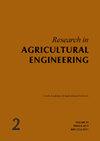Analysis of the physical-mechanical properties of a pelleted chicken litter organic fertiliser
Q3 Agricultural and Biological Sciences
引用次数: 2
Abstract
Pelleted fertiliser production represents improvements in fertiliser management and ensures several benefits, such as a more accurate dosing (less applications), the slow-release of long-lasting nutrients, the possible application during the whole year, easier storage and transportation and better separation of fertilisers and pesticides. The present research investigated the physical-mechanical properties of a pelleted chicken litter organic fertiliser. The pellet samples' particle density ρ (kg·m–3), mechanical durability DU (%), compressive strengths in the cleft σc (N·mm–1) and in simple pressure σp (MPa) were investigated. The last two indicators, σc and σp, demonstrated the pellets' resistance to the compressive stress. The resulting values proved ρ = 1 289.73 kg·m–3, DU = 95.5%, σc = 58.61 N·mm–1 and σp = 20.02 MPa, while all the results were evaluated positively. The observed level of the DU (%) did not achieve the mandatory level for the commercial production of pellets (DU = 97.5%), however, such a level is stated for a pellet solid biofuel intended for energy production. Therefore, the achieved level of the DU (%) represents a satisfactory result within the investigated pellet samples' mechanical quality. In general, the viability and practicability of chicken litter pellet production was proven, as well as, the suitability of such a feedstock for pellet production. Moreover, the observed results proved a high level of the investigated pellet samples' mechanical quality.颗粒化鸡粪有机肥料的物理力学性能分析
颗粒肥料生产代表着肥料管理的改进,并确保了几个好处,如更准确的剂量(更少的施用)、持久营养素的缓释、全年可能的施用、更容易的储存和运输以及更好地分离肥料和农药。本研究对颗粒化鸡粪有机肥料的物理力学性能进行了研究。研究了颗粒样品的颗粒密度ρ(kg·m–3)、机械耐久性DU(%)、裂隙抗压强度σc(N·mm–1)和单压抗压强度σp(MPa)。最后两个指标σc和σp表明了球团对压缩应力的抵抗力。结果表明,ρ=1 289.73 kg·m–3,DU=95.5%,σc=58.61 N·mm–1,σp=20.02 MPa,所有结果均得到了积极评价。观察到的DU水平(%)没有达到颗粒商业生产的强制性水平(DU=97.5%),然而,用于能源生产的颗粒固体生物燃料规定了这样的水平。因此,在所研究的球团样品的机械质量范围内,达到的DU水平(%)代表了令人满意的结果。总的来说,鸡粪颗粒生产的可行性和实用性得到了证明,这种原料也适用于颗粒生产。此外,观察结果证明了所研究的球团样品的机械质量水平很高。
本文章由计算机程序翻译,如有差异,请以英文原文为准。
求助全文
约1分钟内获得全文
求助全文
来源期刊

Research in Agricultural Engineering
Engineering, agriculture-
CiteScore
1.40
自引率
0.00%
发文量
21
审稿时长
24 weeks
期刊介绍:
Original scientific papers, short communications, information, and studies covering all areas of agricultural engineering, agricultural technology, processing of agricultural products, countryside buildings and related problems from ecology, energetics, economy, ergonomy and applied physics and chemistry. Papers are published in English.
 求助内容:
求助内容: 应助结果提醒方式:
应助结果提醒方式:


